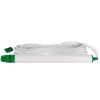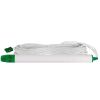Proactive Power Booster 2 Controller
Features
- Increases voltage output on 12V battery from 12 volts to a constant 19 volts
- Low voltage disconnect (LVD) at 10.75 volts turns off the controller or allows pump to pulsate
- Includes 7' wire lead to battery clamps and 8' wire lead to pump connector
- Free ground shipping
- Expedited repair and warranty service
- Lifetime technical support
- More
Overview
The Proactive Power Booster 2 is engineered specifically for the Tsunami, Hurricane, and Monsoon high-performance pumps. This Booster works by increasing the voltage output on a 12-volt battery from 12 volts to a constant 19 volts.
Benefits
- Engineered with reverse polarity protection
- Advanced thermal overload protection
- Heavy-duty steel weatherproof case
- Low voltage disconnect (LVD) at 10.75 volts (turns off the controller or allows the pump to pulsate)
- Constant Voltage Boosting Technology (CVBT) allows the correct voltage to reach the pump motors
- 30 AMP "safety" fuse to protect electronics and user
- 6-month parts and labor warranty
- 'Ramp Up' control dial
- 7-foot wire leads to battery clamps and 8-foot wire leads to the pump connector
- Steel handle for comfort and control
In The News
Supplying Seattle’s Drinking Water: Using Data Buoys to Monitor the Cedar River Municipal Watershed
Providing clean, safe, and reliable drinking water for the 1.6 million people in the greater Seattle area is a top priority for Seattle Public Utilities (SPU). With limited water supplies, SPU dedicates considerable resources to maintain its watersheds and mountain reservoirs. About 70 percent of Seattle Water comes from the Cedar River Municipal Watershed , and the other 30 percent comes from the South Fork Tolt River Watershed . [caption id="attachment_39574" align="alignnone" width="940"] Data buoy in Chester Morse Lake . (Credit: Kevin Johnson / Seattle Public Utilities) [/caption] Jamie Thompson, a fisheries biologist at SPU, monitors aquatic ecosystems centered on fish listed under the U.S. Endangered Species Act (ESA).
Read MoreData-Driven Advocacy on the Lower Deschutes River
Like many freshwater environments, the Deschutes River in Oregon is under pressure from development, pollution, and climate change. Many rivers, streams and lakes in the Deschutes Basin do not meet Oregon water quality standards –where state water quality monitoring assesses levels of bacteria, pH, dissolved oxygen, temperature, and fine sediment. Hannah Camel is the Water Quality Coordinator for the Deschutes River Alliance (DRA), a non-profit organization that focuses on the health of the lower 100 miles of the Deschutes River–the area most affected by human intervention. As a data-driven organization, the DRA has benefited from the installation of two NexSens X2 data loggers.
Read MoreExpanding the Port Everglades: Real-Time Monitoring of Water Quality Conditions from Planned Dredging Operation
The Port Everglades in Broward County, Florida, serves large trade vessels and cruiseliners and incoming and outgoing recreational boaters. However, as cargo ships become larger, the port must expand. A dredging project led by the US Army Corps of Engineers will substantially deepen and widen the port's navigation channel to accommodate larger Panamax cargo ships and modern cruise liners. As a result of this project, a large amount of sediment will be displaced into the water column. This suspended sediment may settle outside of the project area, burying benthic organisms like corals, and possibly carrying harmful particulates to other regions. [caption id="attachment_39497" align="aligncenter" width="2560"] A CB-950 and CB-25 deployed on site at Port Everglades.
Read More












